Research, Ibusuki and the setting sun in Kashima
Background
In my Japan travel 2024 blog, which is by no means a good documentary on my travel because there is just no time to write down all the events, I neglected the one-day trip I had to Ibusuki (and Kashima). And it was for a good reason, the trip was definitely the highlight of my 2-week travel in Japan and it was by no means reproducible. For this reason I think it deserves a dedicated blog. But before I talked about the travel I’d like to discuss something a bit more academic, for reasons that may or may not become transparent.
Research
I am pretty sure a large minority of people who happen to read my blogs know the site through my work on OCDM, as well as my simulations of multicarrier systems on GitHub. I received about 10~ questions on these subjects during last year through email and pretty much on nothing else. Unfortunately, I am no longer working on communication theory. If it’s not already evident from the front page, my research is now in information theory and its related areas. Though I don’t really consider one area superior than the other, I’d like to offer some perspective on each research direction.
In some way I’d like to think information theorists and communication theorists on a spectrum of engineering-mathematician where the former is far more technical and latter much more practical, and I don’t think this is a debatable observation. In reality, there is probably a maximum cardinality on the set of mathematical tools you can bring to an engineering problem to still keep it practically relevant. And the reason is the following, with communication theory you can’t really go to much beyond that of SINR, because it is the most practically applicable metric of quality of communication over Gaussian channels. Therefore, at least a small majority of papers in those areas aim to simulate or maximize SINR, under various settings. And the tools are remarkably consistent, you begin with some linear algebra and matrix theory, followed by some convex analysis on the objective function. It is by no means easy, since the folks that employ such metrics are way too good with optimization techniques. I am convinced that you can find most performance analysis problems in wireless communication and turn it into an optimization problem over Gaussian channel capacity under some power constraint. Fortuitously, because these optimization tools are so widely employed, and the problems they tackle are often rooted in application, there are probably less gatekeeping.
What I mean is the following. In general, engineering is nothing but application of mathematical tools for practical settings. The tools are remarkably consistent yet practical settings can vary greatly, for which reason the problems become very dangerous to tackle when there is no obvious practical setting. This is quite common in information theory, when all you are doing is to find the optimality of an abstract model, the same that other people also have access to. For instance, if you touch one of those fundamental problems in communication exponents, you probably get destroyed at review by one of those experts like Prof. Merhav, because generally there are much more gatekeeping around research questions that are not application oriented, due to a wider range of mathematical tools that are employed. And unless you are a genius, you don’t know what they do. And this is not mainly because of the math, but rather the idea by which they arrive at the result. Most of the time they need some techinical assumptions/motivations to arrive at the results they want, which are sometimes very subtle. If you miss the ideas behind the papers, all the math suddenly look like the work of god, because although the equations may eventually make sense, you have no idea how they come up with such approaches, and that to me is the more challenging part of theoretical works.
There are always tradeoffs in multiple dimensions, for the fun one might enjoy with theory and probably more demanding mathematical reasoning.
For someone who had some experiences in both communication theory and information theory. I’d be lying if I don’t say information theory is much harder to research, for the exact reason I mentioned above (perhaps why it’s attempted by much fewer people). So how are these related to Ibusuki travel? Well, take it as the reason the travel blog comes out only now, and not in January.
Ibusuki
Before I begin I have to mention that I finally decide to write down the travel because of this amazing video I came across, which is about cycling the entire length of Japan. And not surprisingly, their journey begin at the tip of Mt. Kaimon, which is the mountain you see in the thumbnail to this blog, coincidentally also the Southern tip of Japan and, situated 900 meters above sea level near the city of Ibusuki, south of Kagoshima.
A short rundown of the trip
During this one-day trip, I was accompanied by my cousin Jane, long-time friend Eshan, whom I know from Georgia Tech, and two other friends we met during travel: Valentina, who is the mastermind behind this travel rout and she also graciously shared the car she rented (this trip would not be possible without a car); Max, a German-Korean with whom I also shared the road in Fukuoka. It’s interesting to mention that the diversity of this travel group is definitely a highlight of the trip, as we were able to write Ema in 5 different languages.
We arrived at Ibusuki JR station by boarding the famous “Ibusuki no Tamatebako”, which is a limited express operating between Kagoshima-Chuo and Ibusuki Station. We head towards lake Ikeda and make our first stop at the “Golden Torii”, north of the lake Ikeda, with a short stay at the Yokatoko cafe. We drove around the lake before having lunch at Municipal Tosenkyo Somen-noodle Restaurant. We then head further south to visit the Hirakiki Shrine, at the northen tip of Mount Kaimon. We then roam around the mountain along the coastal road, during which we attempted a rather intense climb down from the tip of cape Kaimonzaki to the sea level. Finally, we make our way towards Nishi-Oyama JR station, which is the Southern-most JR station of entire Japan. We finished our day by having a sand bath experience at Saraku Sand Bath Hall and a dinner at Aoba, near Ibusuki Station.
The day was extremely eventful, the only regret was that we weren’t able to climb Mt. Kaimon due to shortage of time and that I didn’t bring enough cash. We were only able to board the JR line back to Kagoshima thanks to the generousity of Valentina.
Tamatebako
From Kagoshima-chuo Station there is a direct JR line to Ibusuki Station. You can either board the normal JR train or the limited expressed called “Ibusuki no tamatebako” (Note that it’s about 2000 Yen more expensive and you do have to reserve the seats). The express is quite themetic as it is painted one side black and one side white, signaling the fact that one side faces the ocean while the other faces the mountain. Once you get on board the express it becomes obvious that there are way more seats than ticketed as all the seats facing the ocean are open for passengers to enjoy the scenic view. The entire express is three carriages long, each decorated differently. And as you can see from the pictures, since it was near Christmas, there was a Santa Claus walking around handing out candies, amongst other exclusive events.
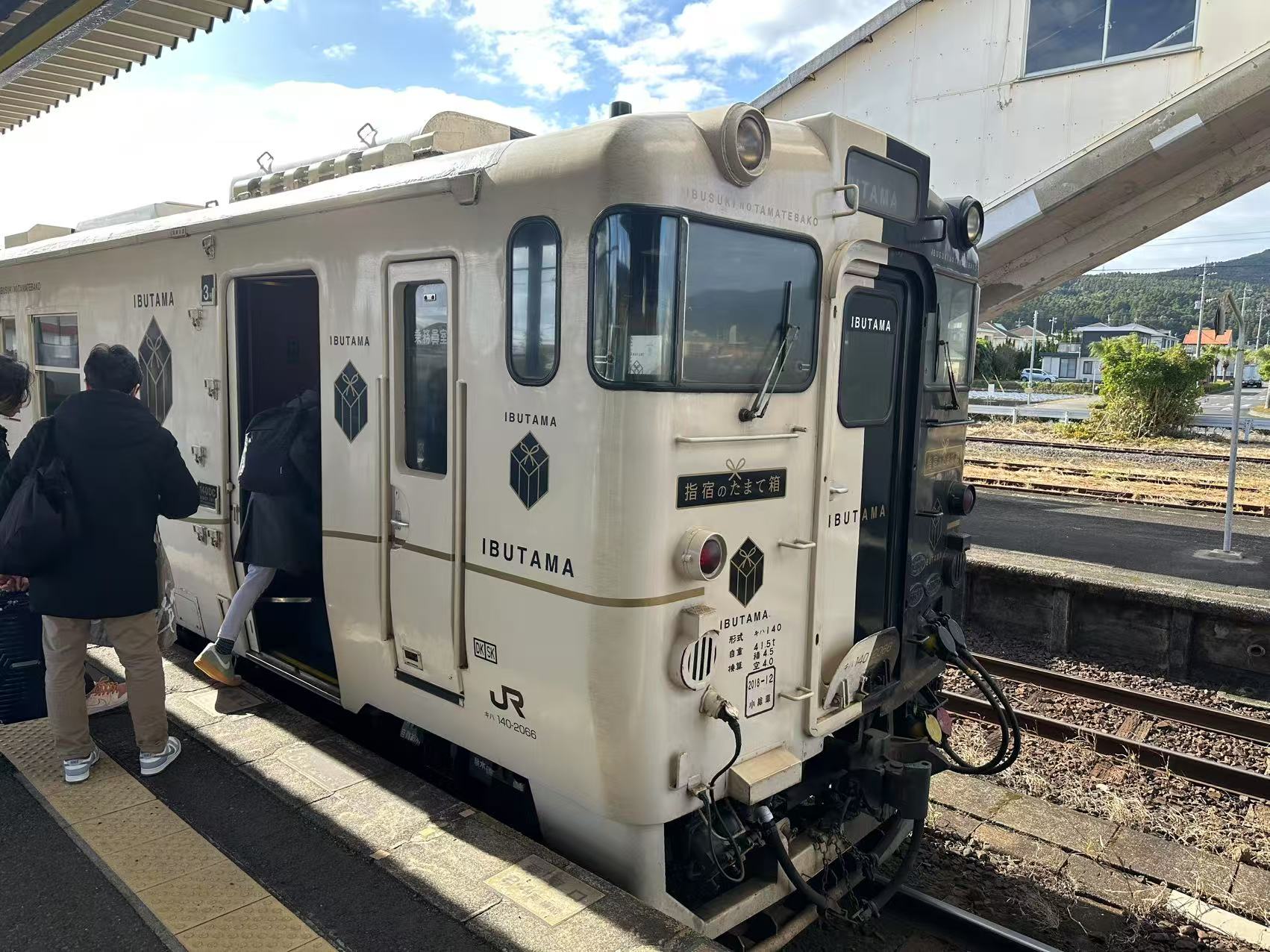
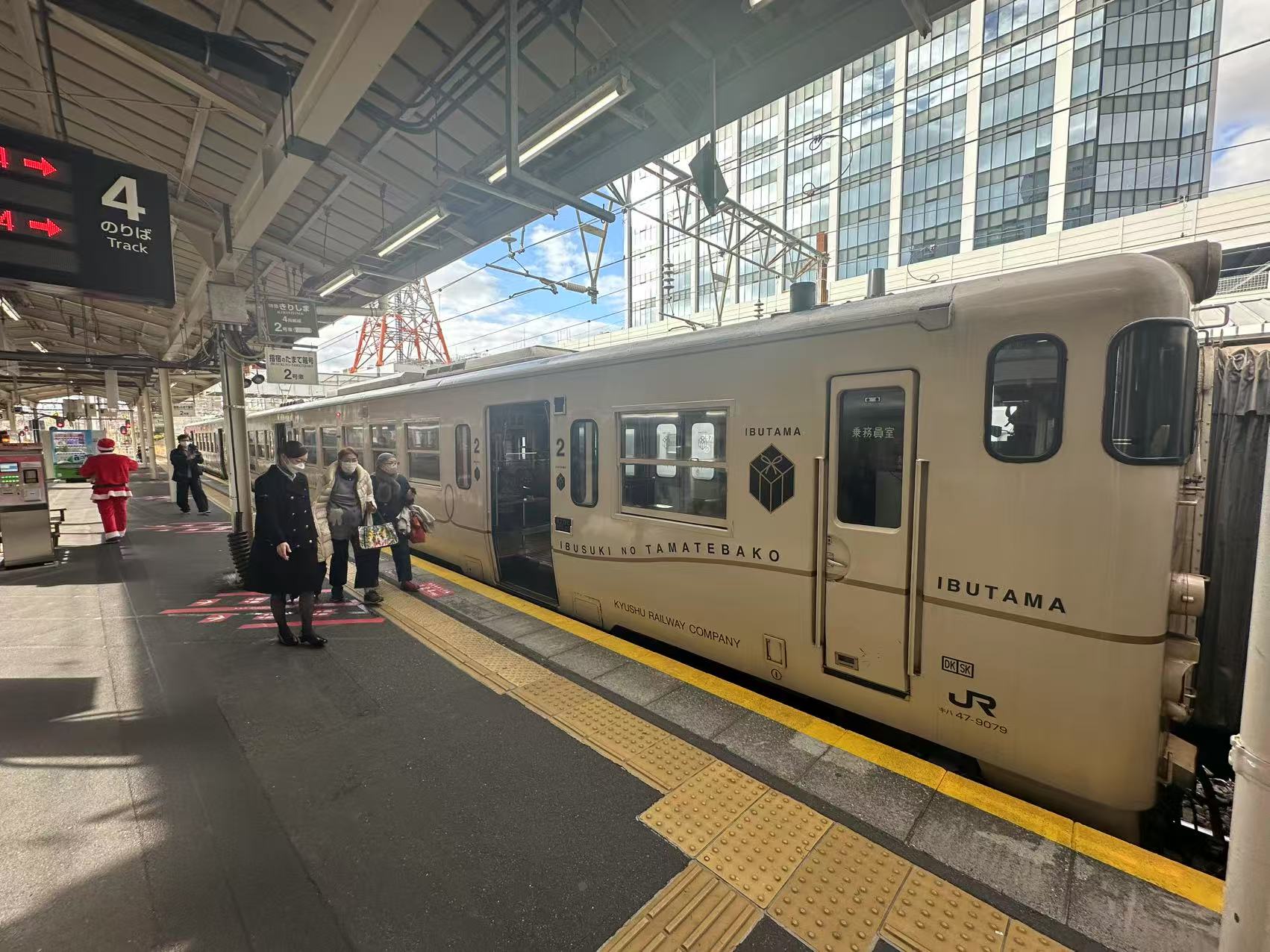
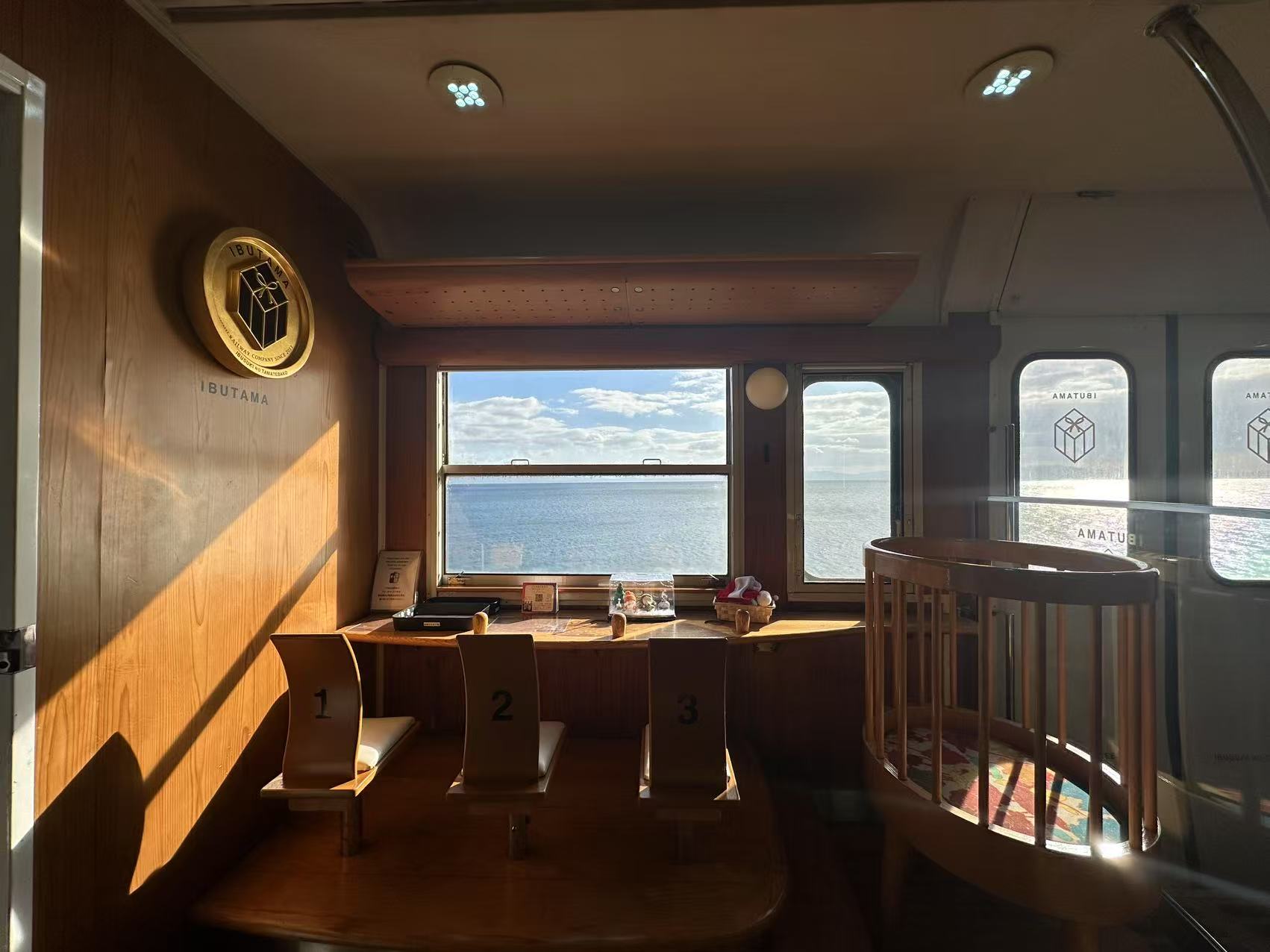
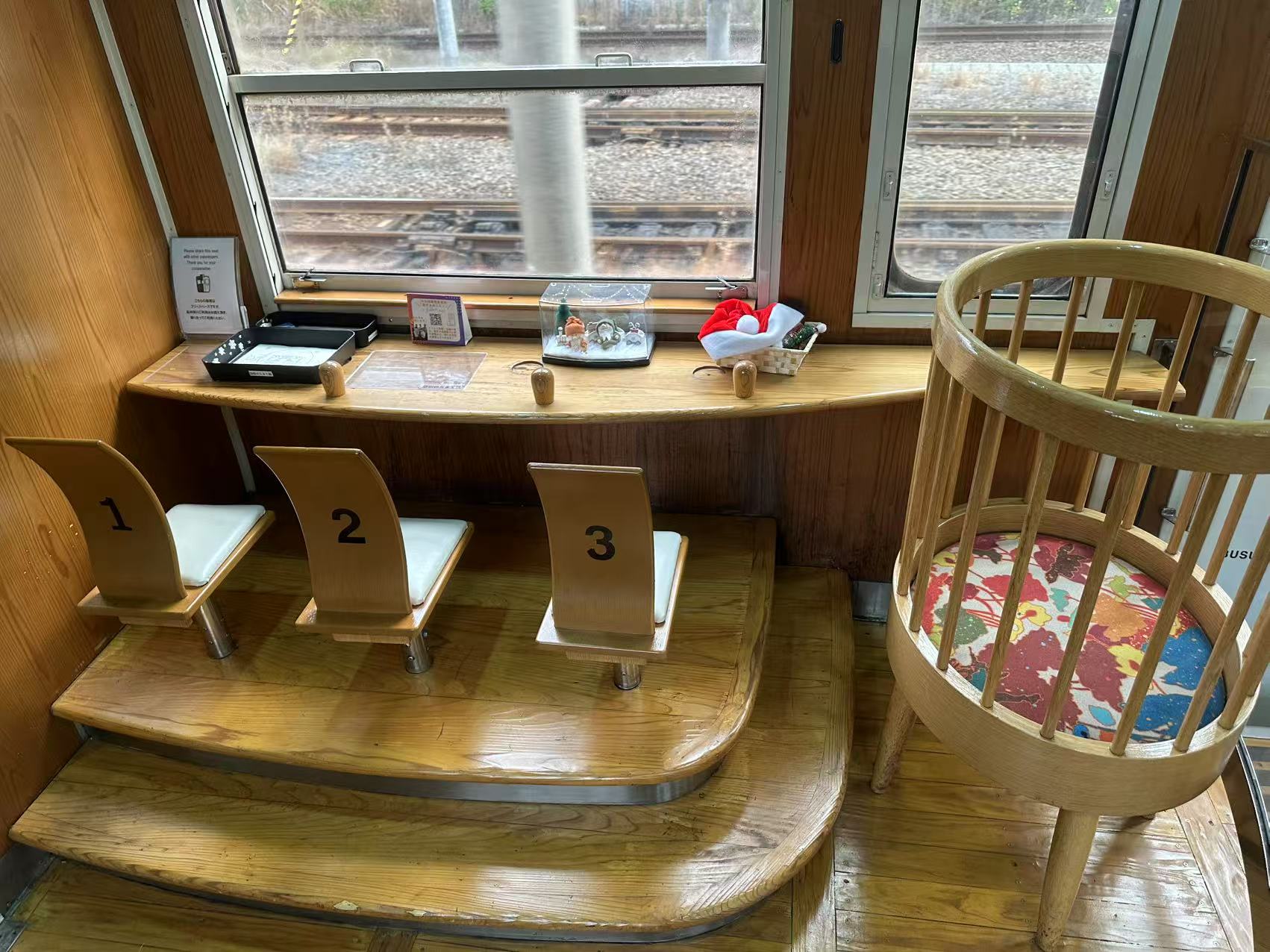
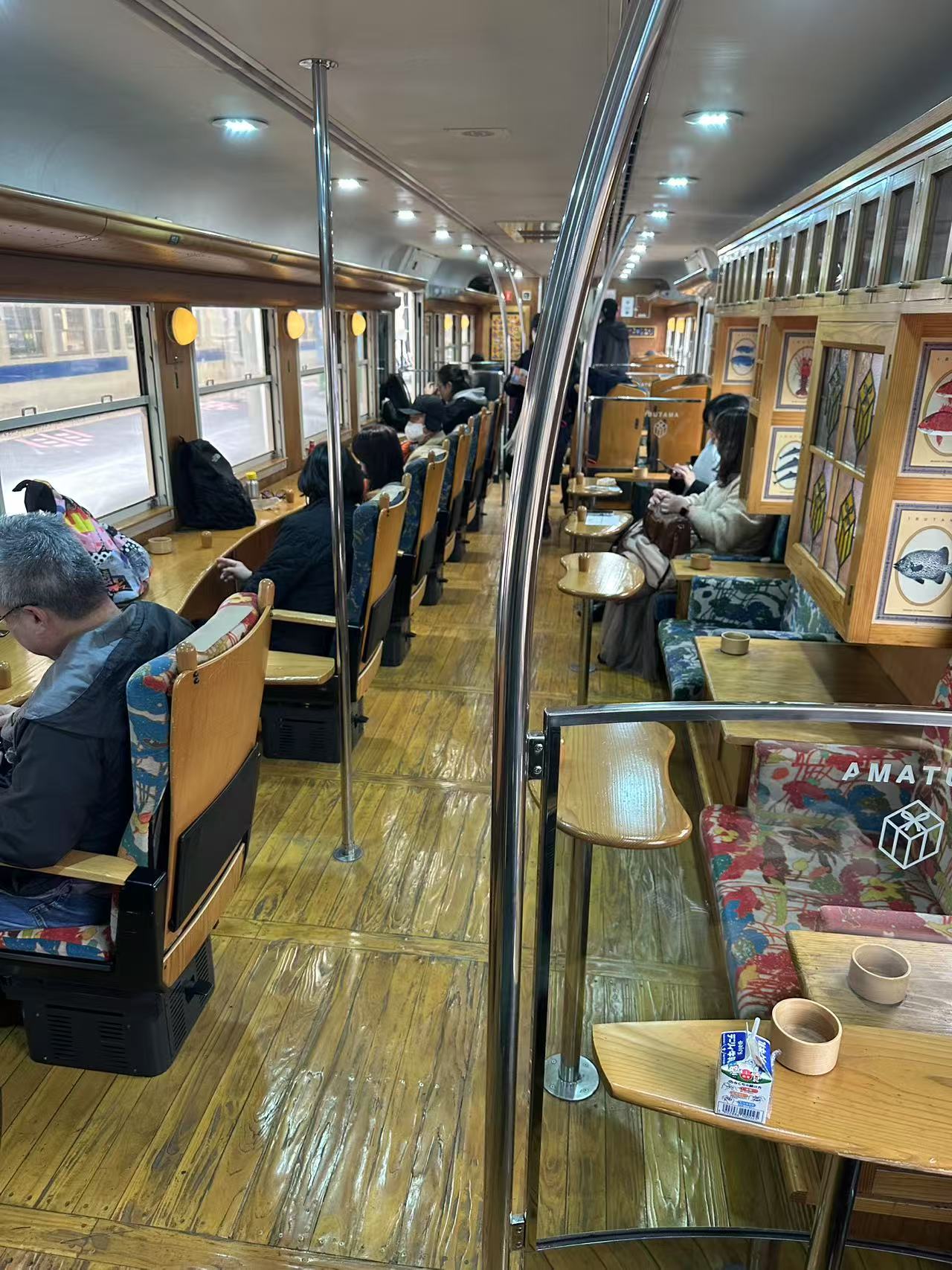

Golden Torii/Yokatoko Cafe
The drive to the Golden Torii around Lake ikeda is quite breathtaking and we made a few short stops along the way to oversee the lake as Mt. Kaimon lurks in the background.
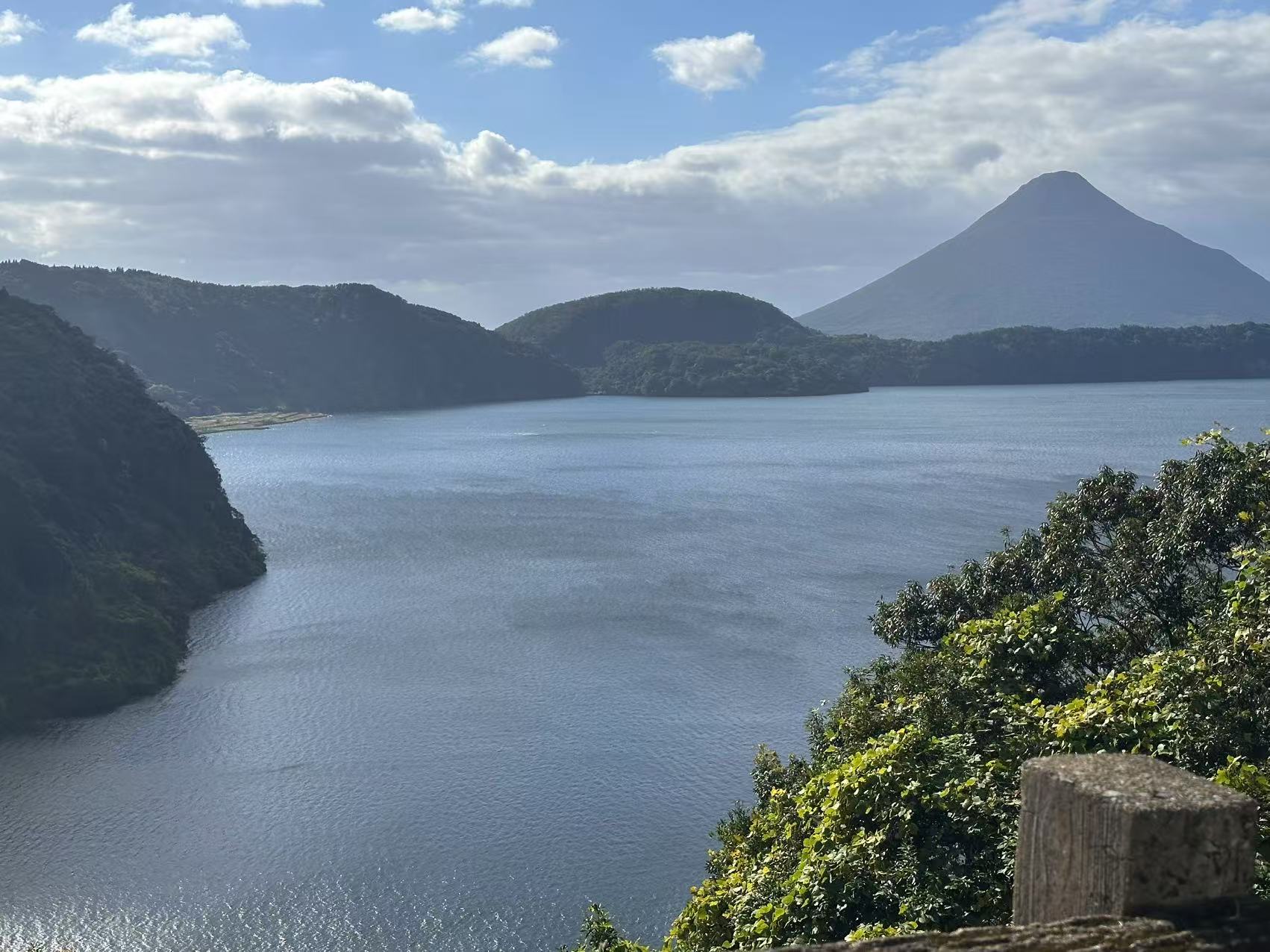
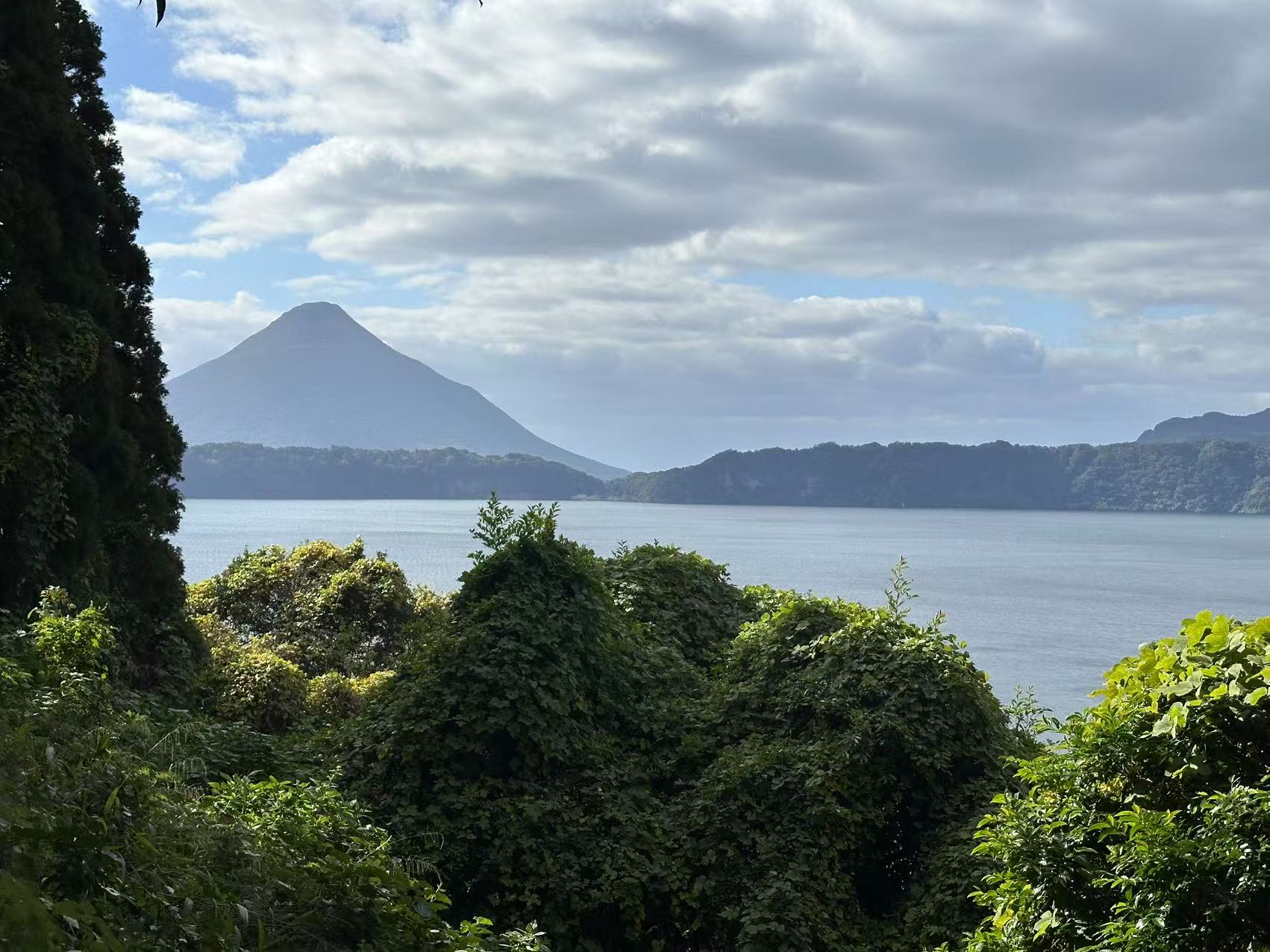
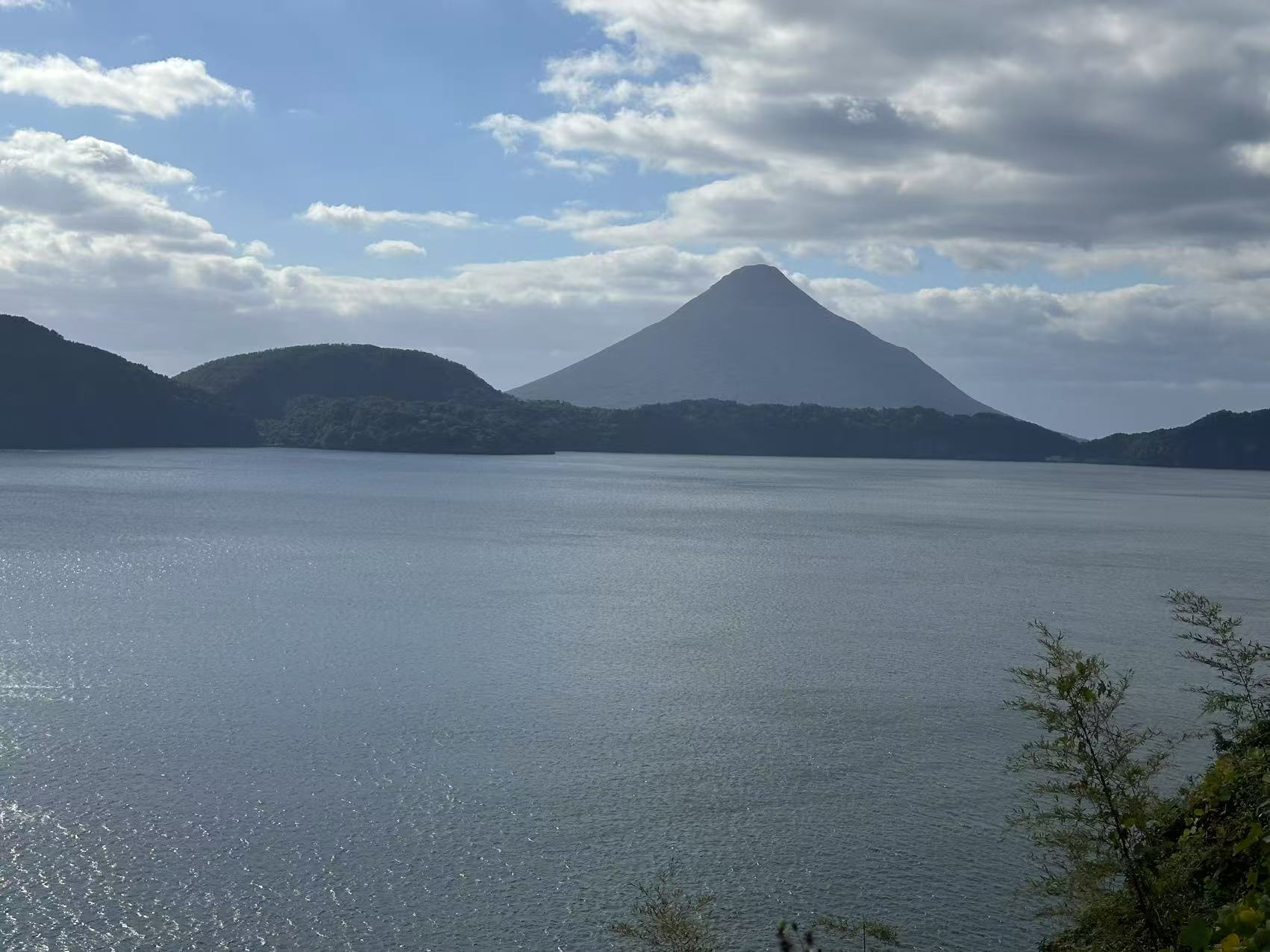
For me the golden torii is just a torii that’s painted golden, but what’s amazing was the view from the torii, as you can see the tip of Mt. Kaimon align perfectly with the top of torii, across the Lake Ikeda. In addition, we also rested a bit at The yokatoko cafe (And I realized I don’t have a picture of it for some reason). Perhaps because the owner of the cafe was very cordial and we conversed the whole time so I didn’t have time to take pictures.

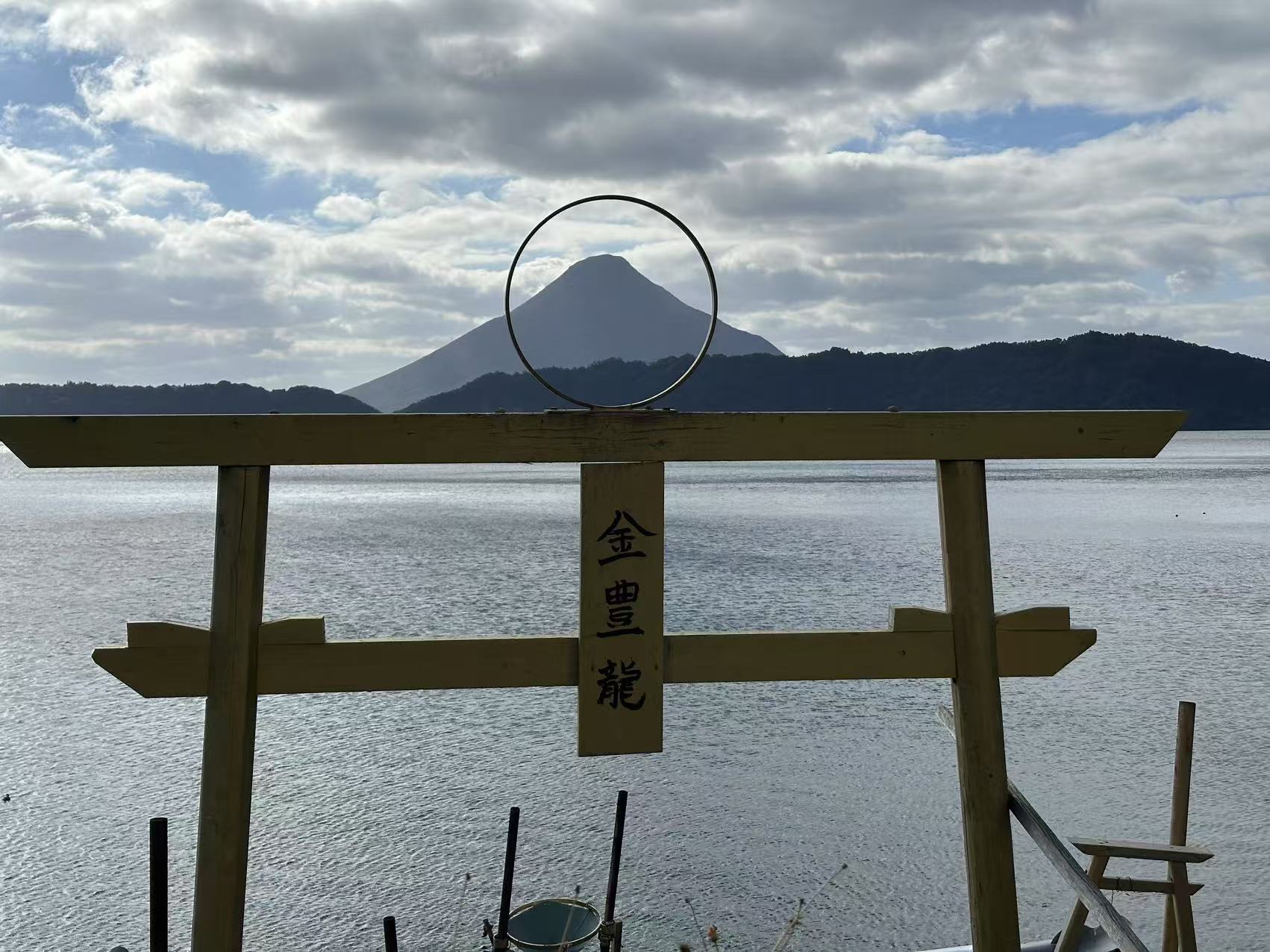
Municipal Tosenkyo Somen-noodle Restaurant
This place is quite interesting unexpectedly. For those who don’t know, Somen is basically a eating style where you “catch” noodles as they stream down flowing water. In this case, the noodles are placed in a round glass structure and keeps flowing circularly (I was never able to figure out how they propel the waterflow). The locale is what stands out to me, despite regulated by the city, as evident by the inclusion of “municipal” in its name, the restaurant is situated in a rather reclusive spot. As we make our way into the restaurant, it looks like some sort of village-structure, with a river and a small shrine along the way.
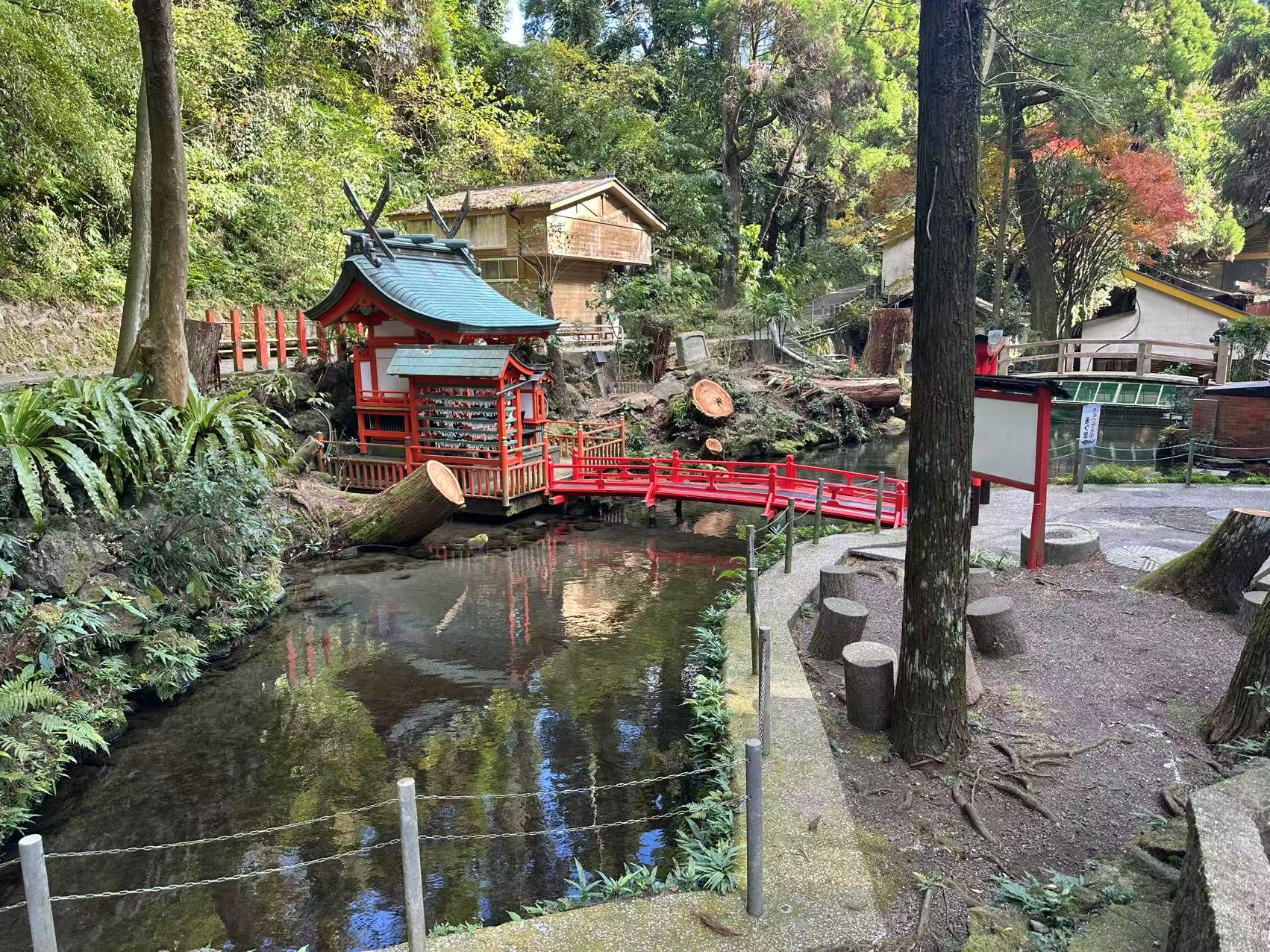
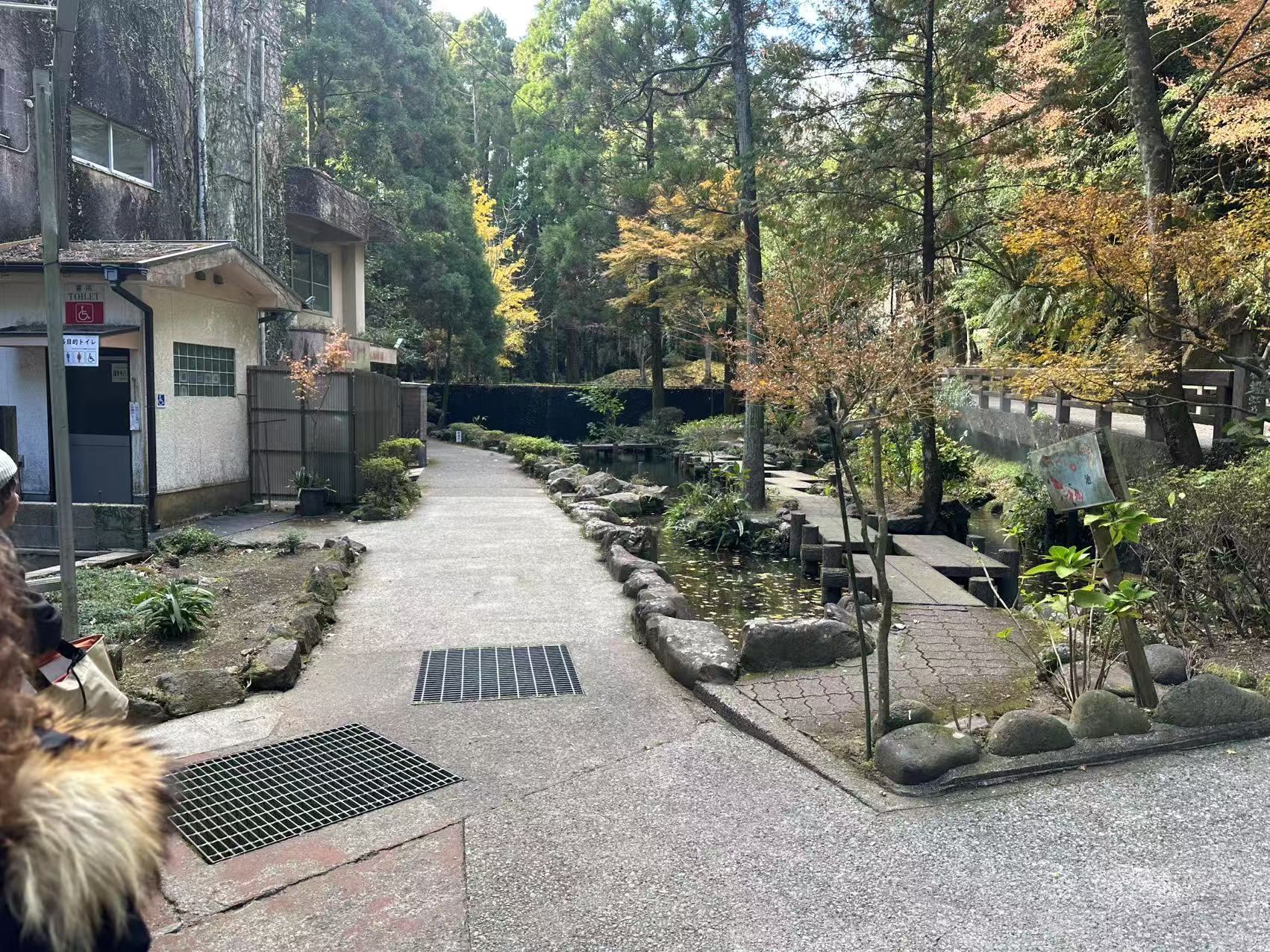
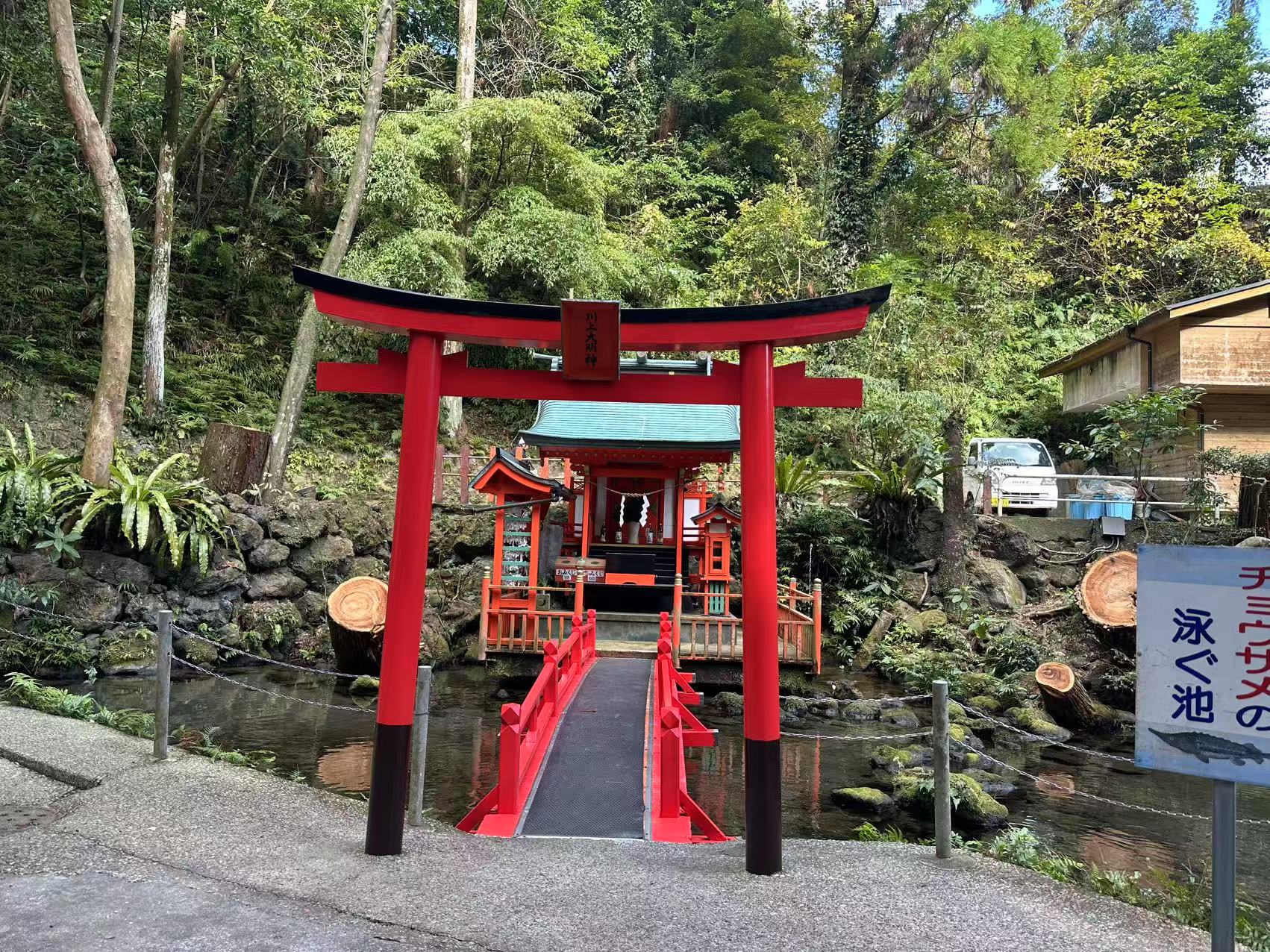
Unfortunately, I don’t think winter is the best season to visit this place. It’s rather chill and we pretty much have the restaurant to ourselves. I think the noodles were quite good, but there are ungodly amount of bones in fishes, that it would even bemuse the most skilled chopstick user, (even in Sashimi, which I have never heard of, but thankfully I didn’t order).
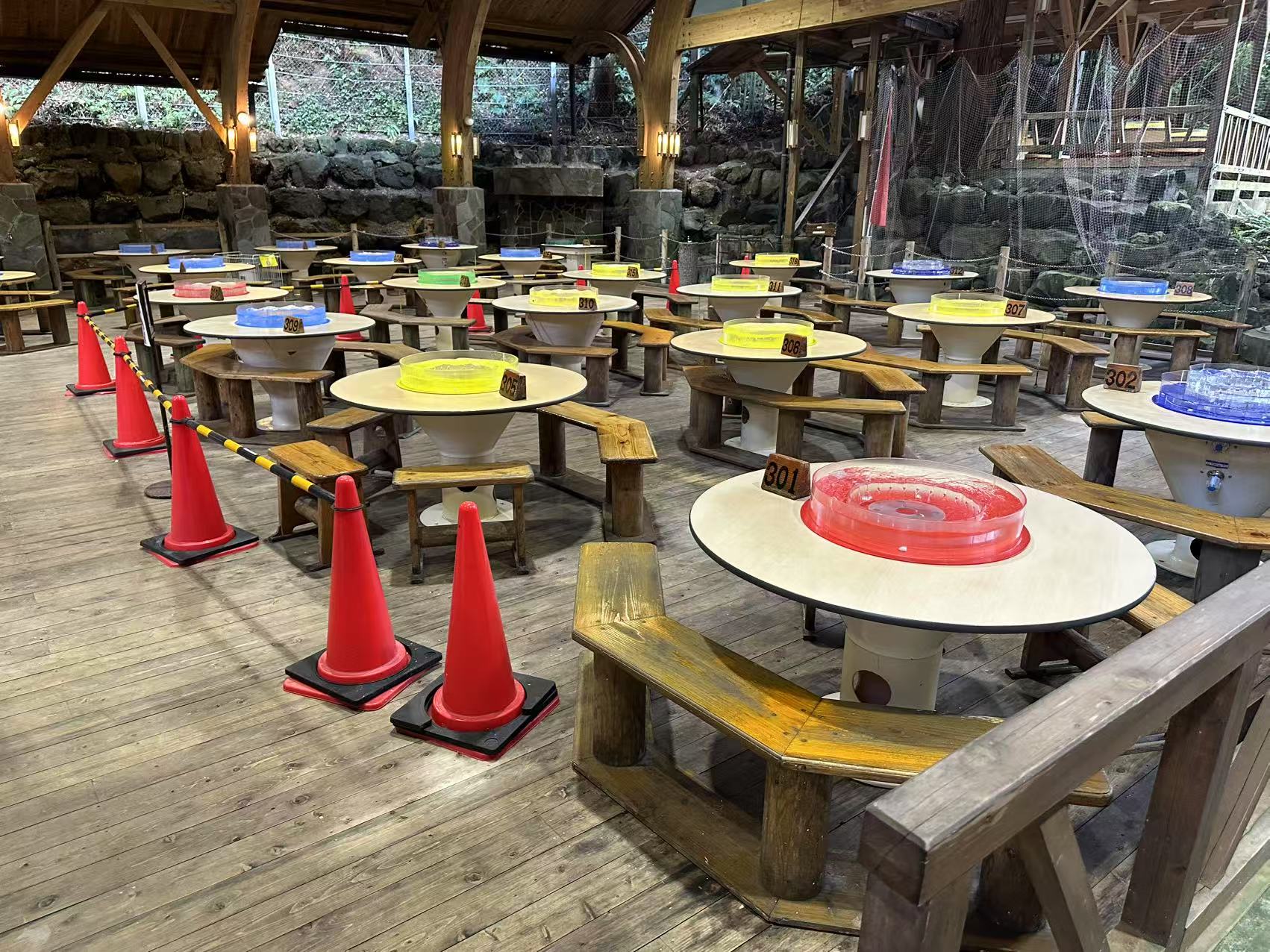

Hirasaki Shrine
I only later know that this shrine claims the ichinomiya of Satsuma Province. The shrines in Japan share certain hierarchy, where the top shrine is obviously Ise Jingu in Mie. The shrine with highest rank in each province is called Ichinomiya, which Hirasaki Shrine claims. To be fair, the claim is in competition with Nitta Shrine, but it’s still very impressive. I did not realize that because the shrine is in a rather under-visited area of Ibusuki and in fact quite far from the Ibusuki Station, the entrance was quite ordinary, which belies its massive interior. It was here that the five of us wrote an Ema in five different languages (Chinese, English, Japanese, Italian and German), in which I delusionally wished to graduate PhD in three years, which I now realize is never going to happen.
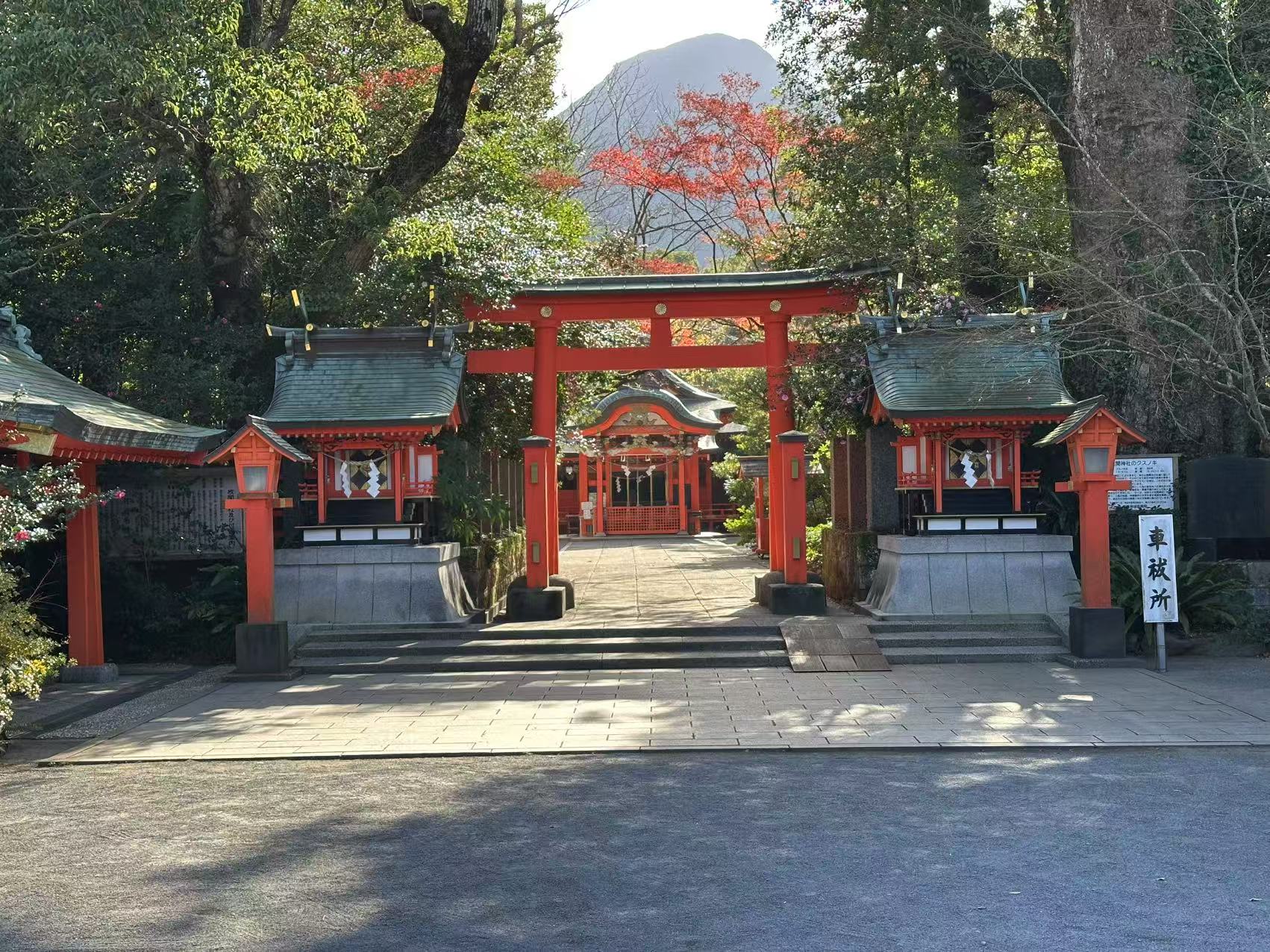
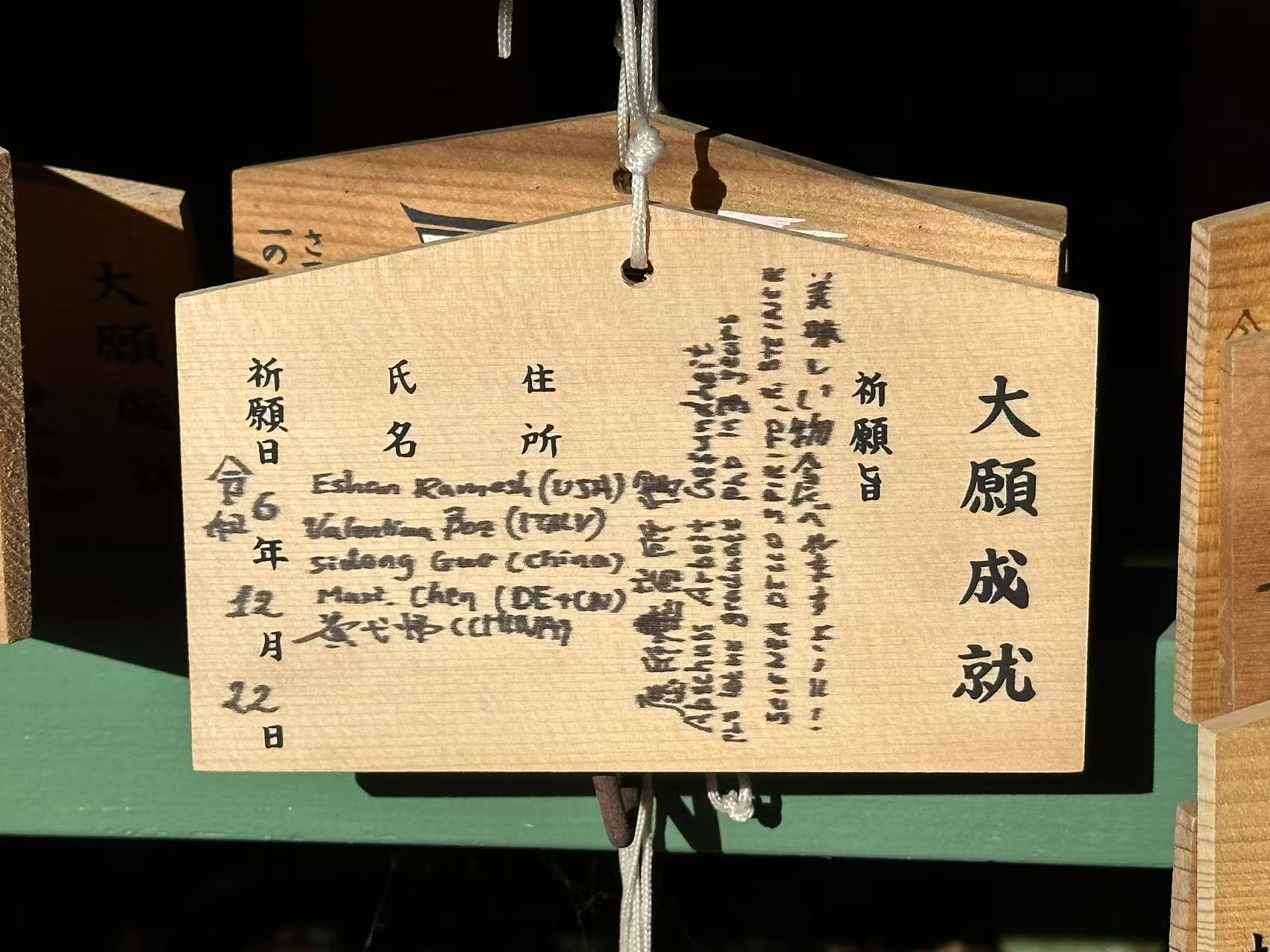
Cape Kaimonzaki
This is the southern tip of Mt.Kaimon, where there is a secretive narrow passage with the entrance near the side of road that allows travellers to climb down the cliff to the sealevel. The entire rout is safeguarded only by a single rope so it does take some finesse to navigate down the rocks. Fortunately I was quite good at mountain climbing but due to difficulty only three of us made it to the sealevel.

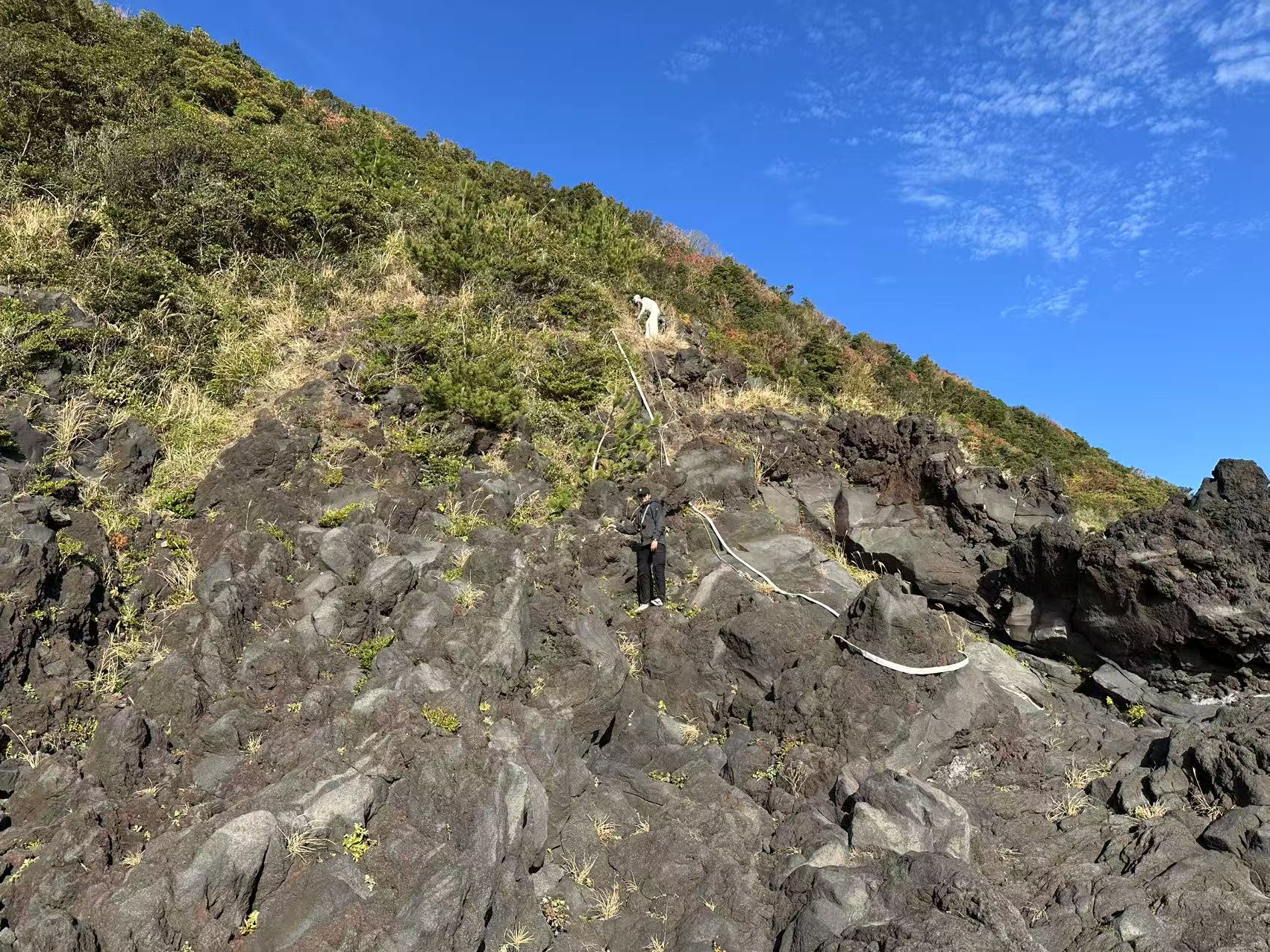
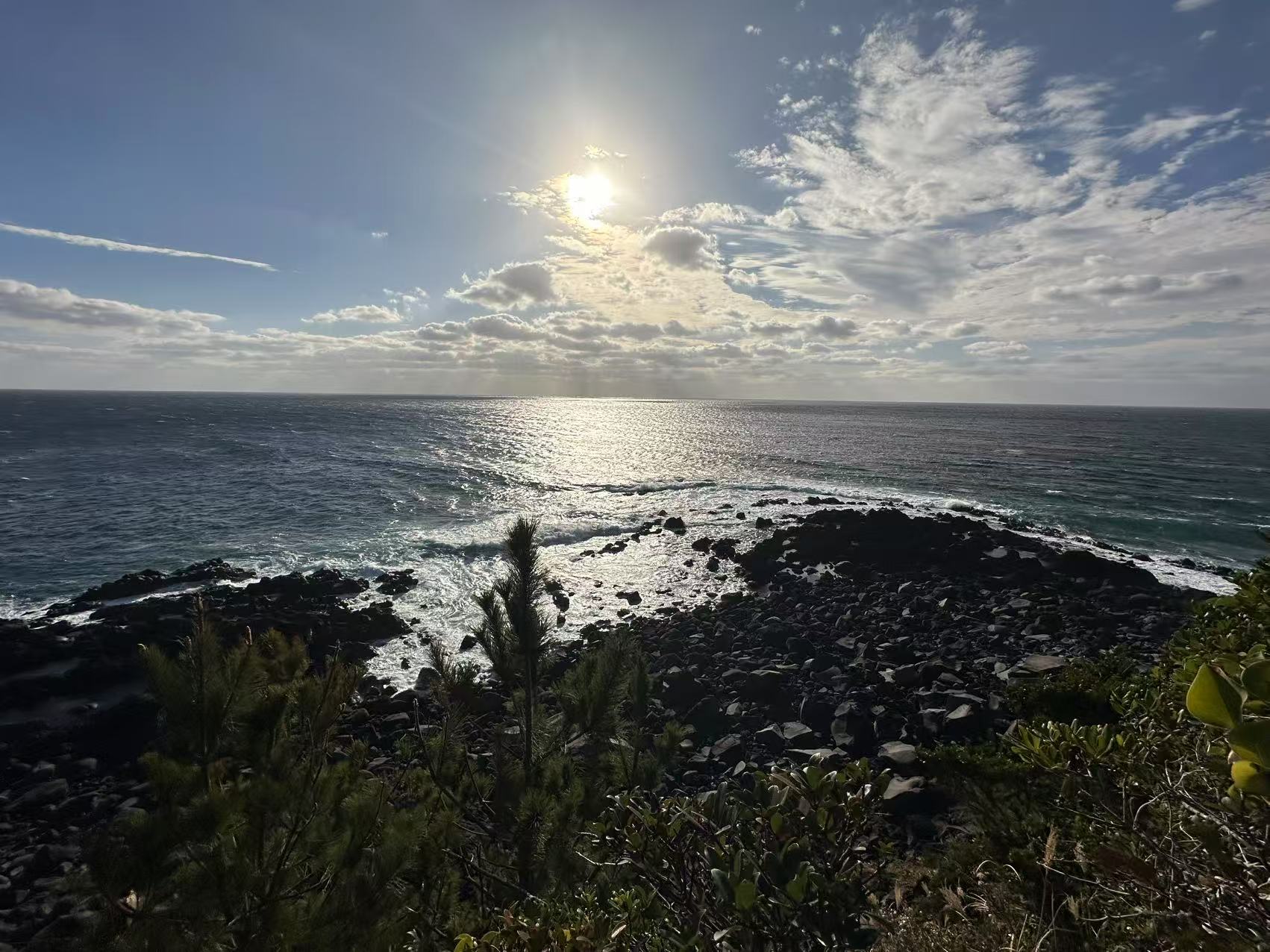
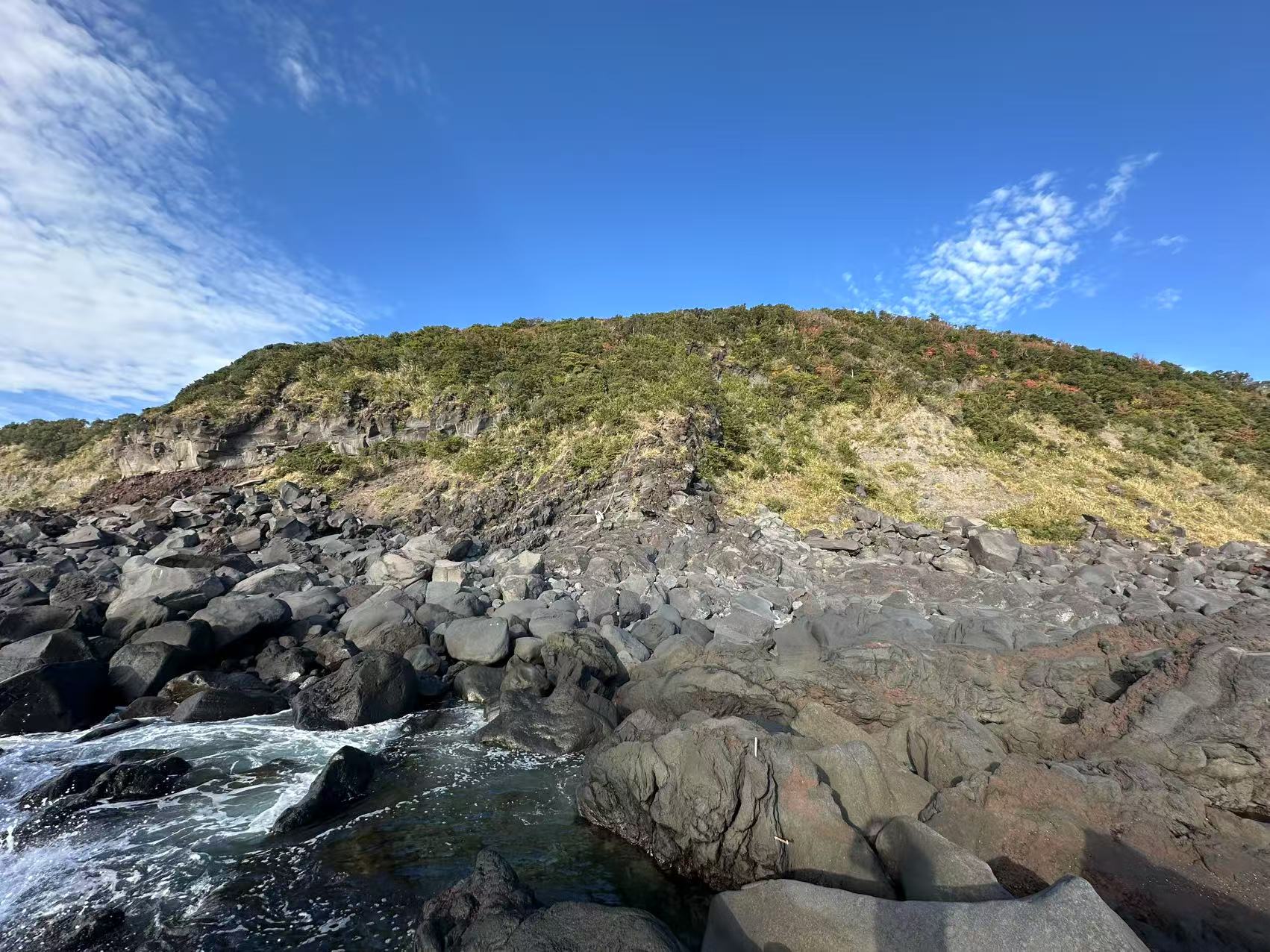
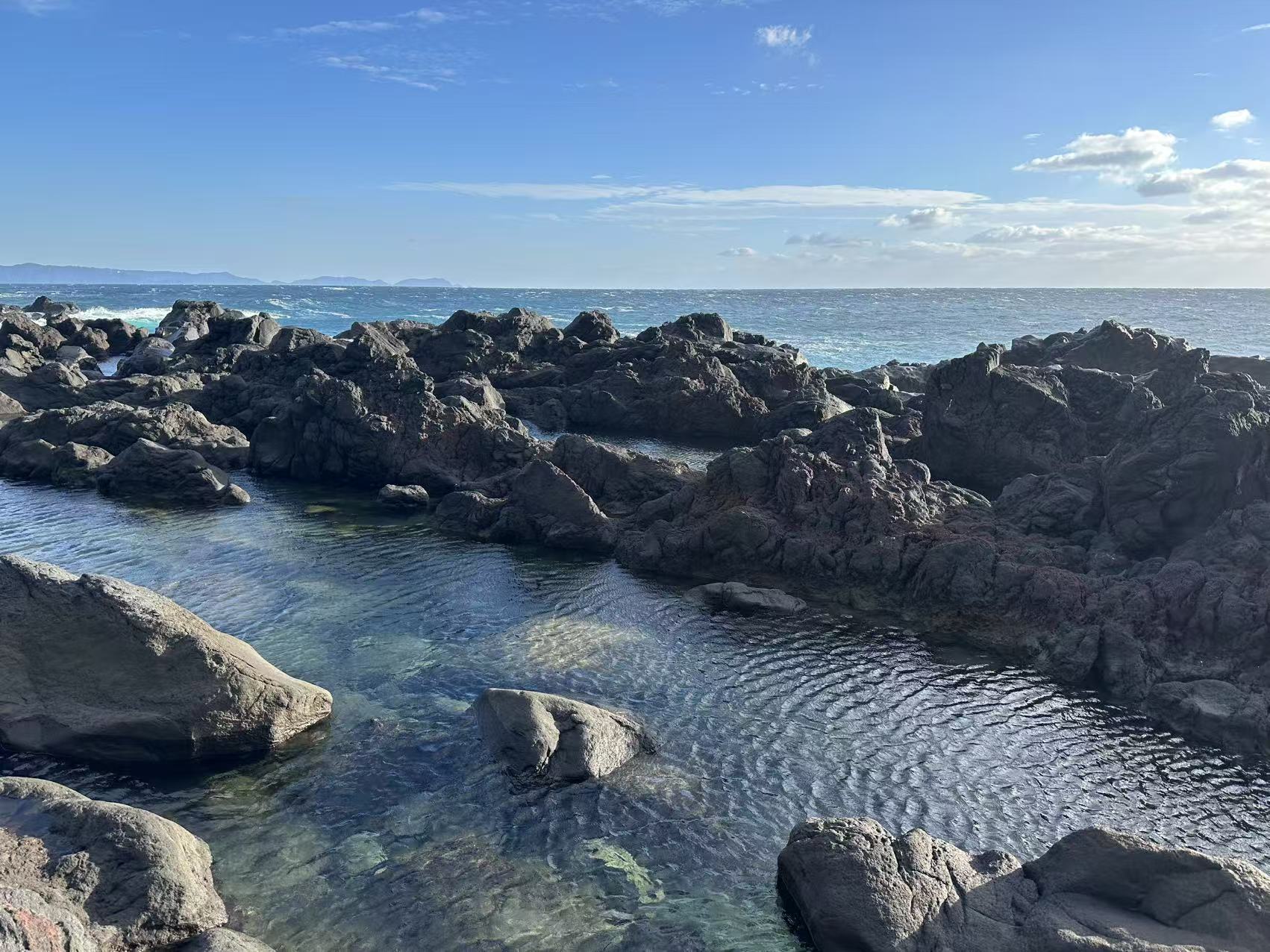
Nishi-Oyama JR station
In my opinion this is a must-go in Ibusuki, not only is this the Southern-most JR station in Japan, the scenic view is almost unmatched, especially around the time we got there. Looking towards the south-west, you can see the monument “Japan’s southern-most station” along with the setting sun, as the only object separating the two is the perfectly shaped Mt.Kaimon. The composition is almost too good to be true. We waited for a while for the next JR line to arrive, as several impatient travelers departed early, but the occasion was absolutely worth the wait.
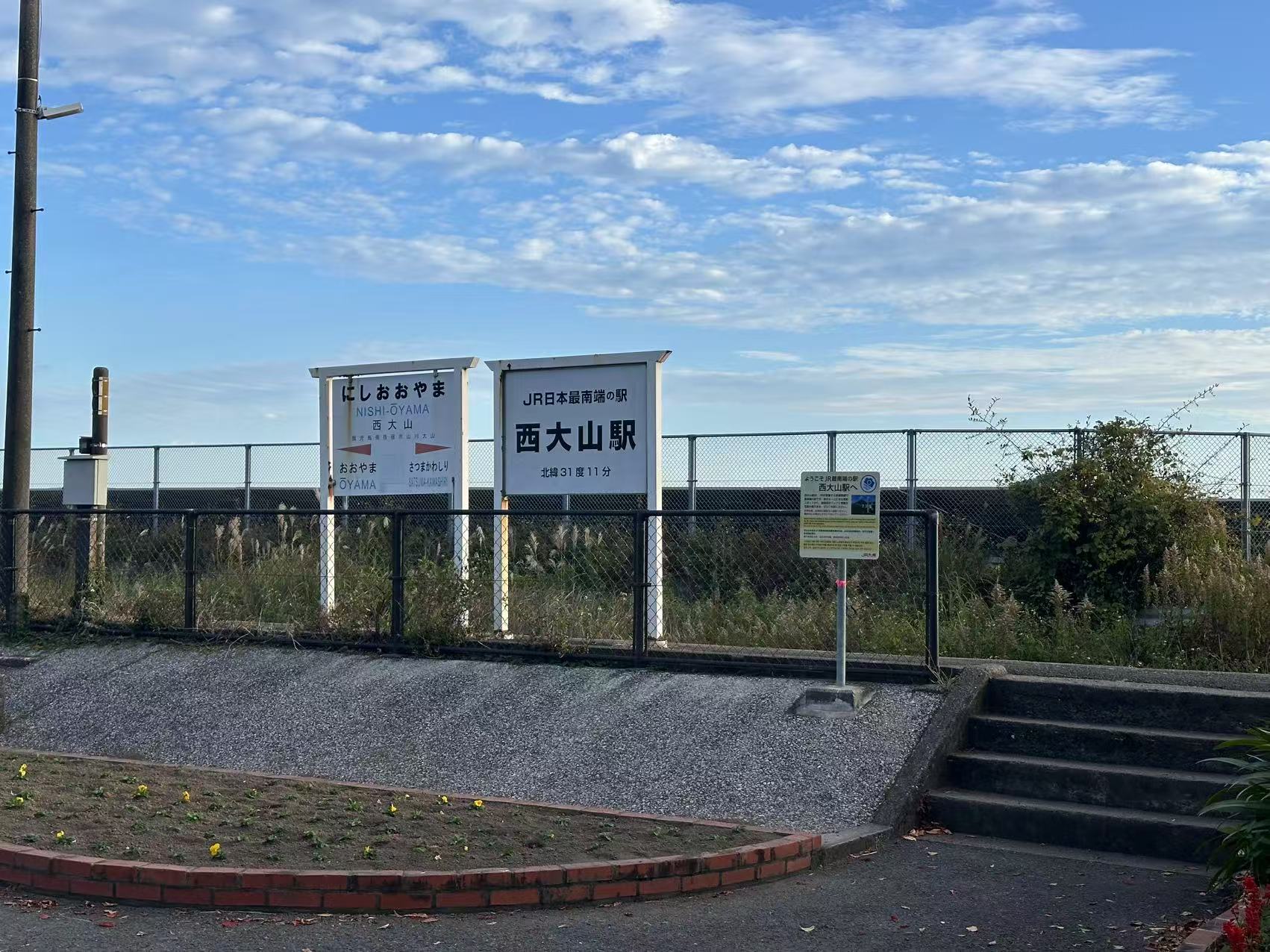
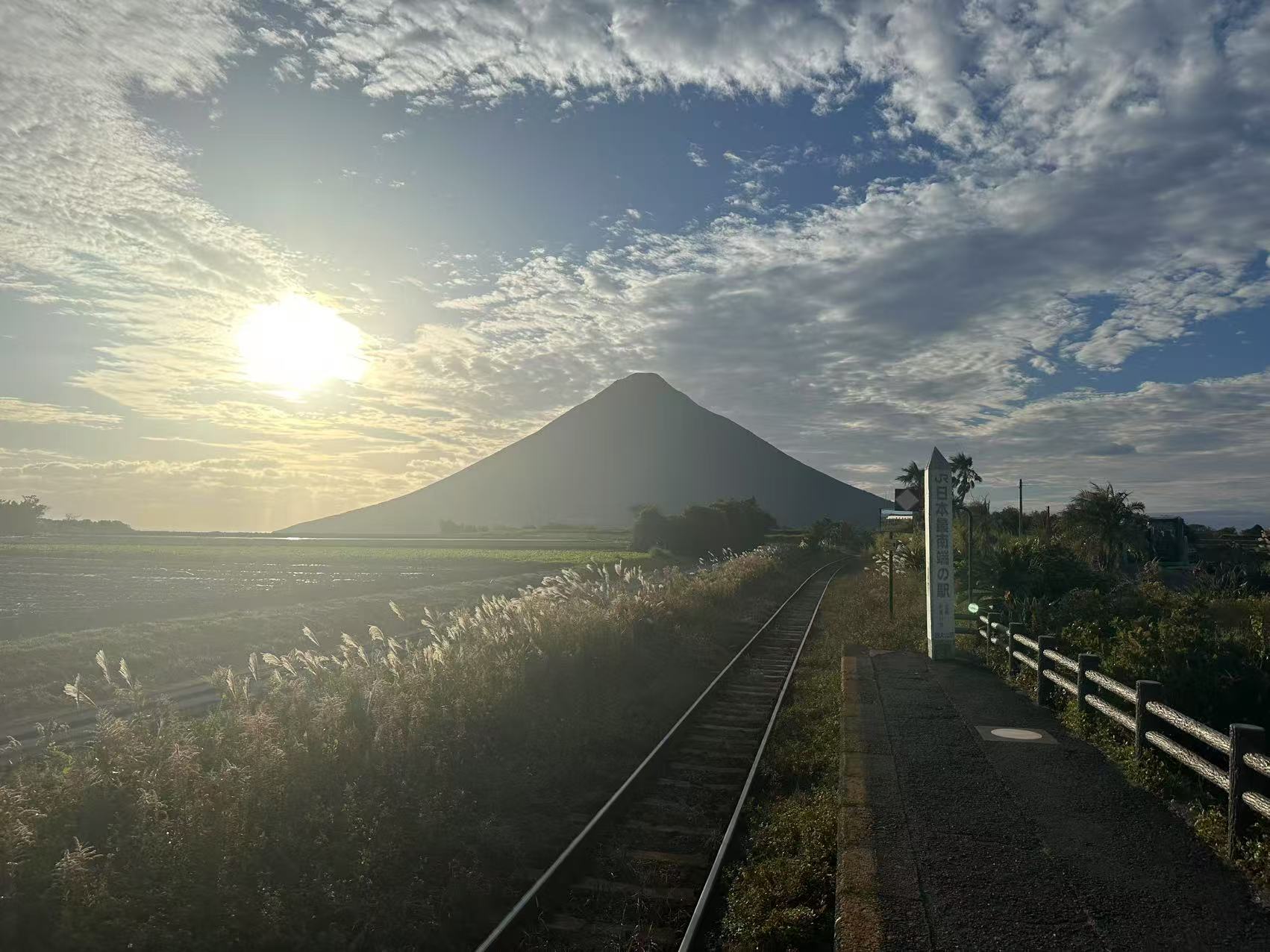
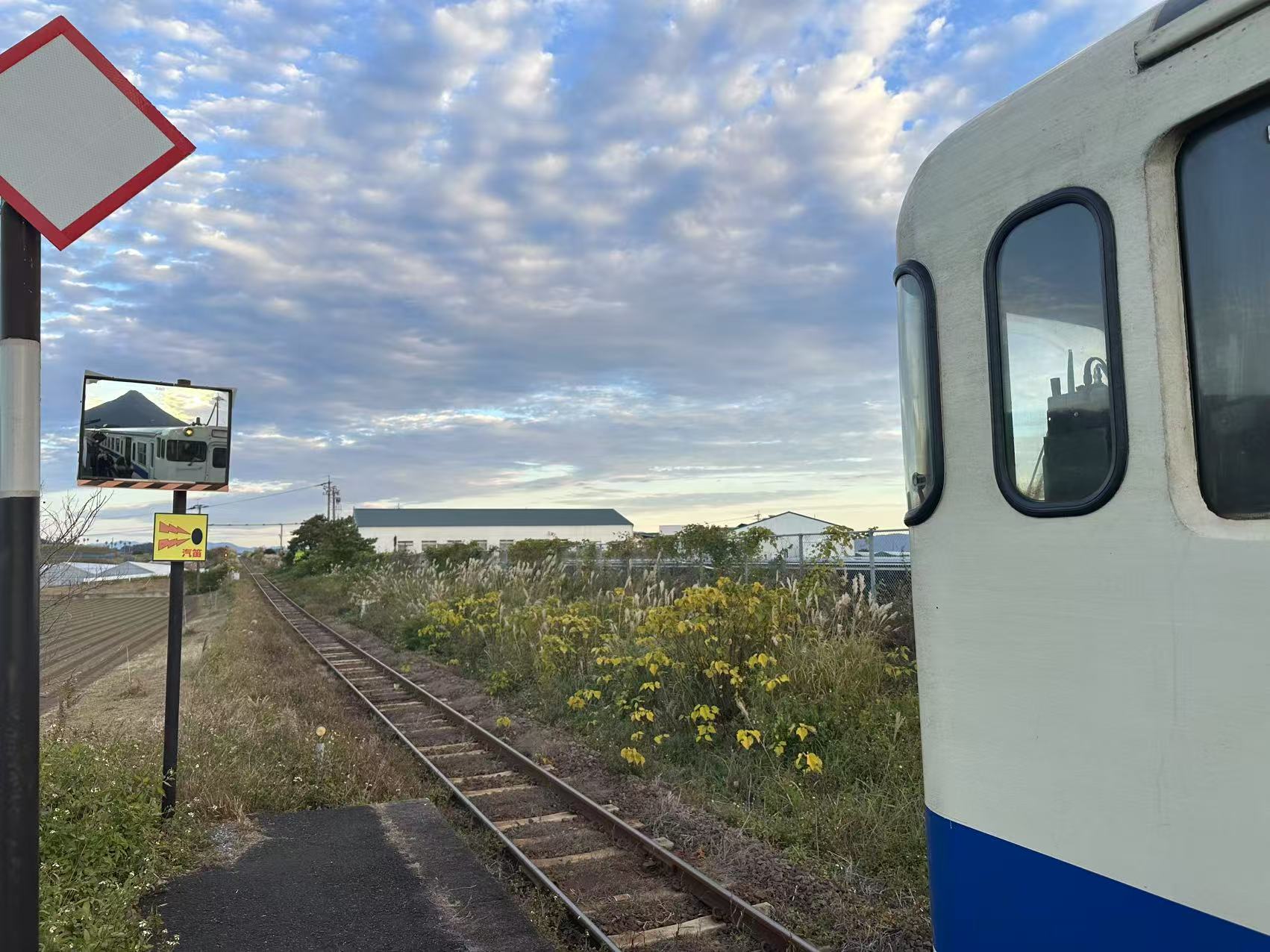
Sandbath Experience
We were obviously not allowed to bring cameras in, but it was truly a surreal experience. Mind you that it was towards the end of year and it was freezing cold in Ibusuki. The sandbath is located near the coast so the walk down the coast while dressing scantily was absolutely miserable. Initially I was doubtful that it will be enough to combat the cold, but wrong I was. Once you lay down, and the workers there immerse you with heavy sand, leaving only the head out, you literally can’t move and the warmth of the sand quickly becomes evident. It was highly satisfying and we were buried in the sand for around 20 minutes before we got out. The clothes we had on were completely wet because we were sweating so much, but funnily you won’t actually realize it during the sandbath. Anyway, this was followed up by an ordinary Onsen where we wash away all the sand. We also enjoyed a great dinner at a local restaurant and some of us also tried the free footbath in front of the JR Station.
Conclusion of Ibusuki Trip
Overall this trip was perhaps one of best one-day trip I’ve had, thanks to the company of a group of highly enjoyable friends. In fact, I think the rout we took was perhaps one of best (Again thanks to the preplanning of Valentina) and I hope it’s of future use to people reading this blog attempting this travel.
Kashima
I want to conclude the blog with a somewhat irrelevant thought, which was my last day at Japan before I departed towards the end of last year. I decided to spend the last day in a lesser-known city around Tokyo, since I’ve been to most of metropolitan Tokyo during previous visits. I settled on Kashima, which is a smaller city near the coast known for the Kashima Jingu. I could do a detailed blog as the one I did for Ibusuki, but I decided to refrain from that, even though the travel was quite good. Kashima Jingu was unbelievably expansive and there are quite few interesting spots, amongst them are a peculiar torii gate holding a tree growing sideways and some deers that you can feed.
However, what was really simultaneously the highlight of the trip and a moment of retrospection was when I visited this famous red Torii on top of the Lake Kitaura (Formally named Kashima Jingu Shrine-West First Torii). I happned to arrive at the torii after a quite tiresome walk from the Kashima Jingu near the sun set hours, and already there are many people waiting for the moment gathering around the coast. Fortunately I was able to sit at the perfect spot for photographing.
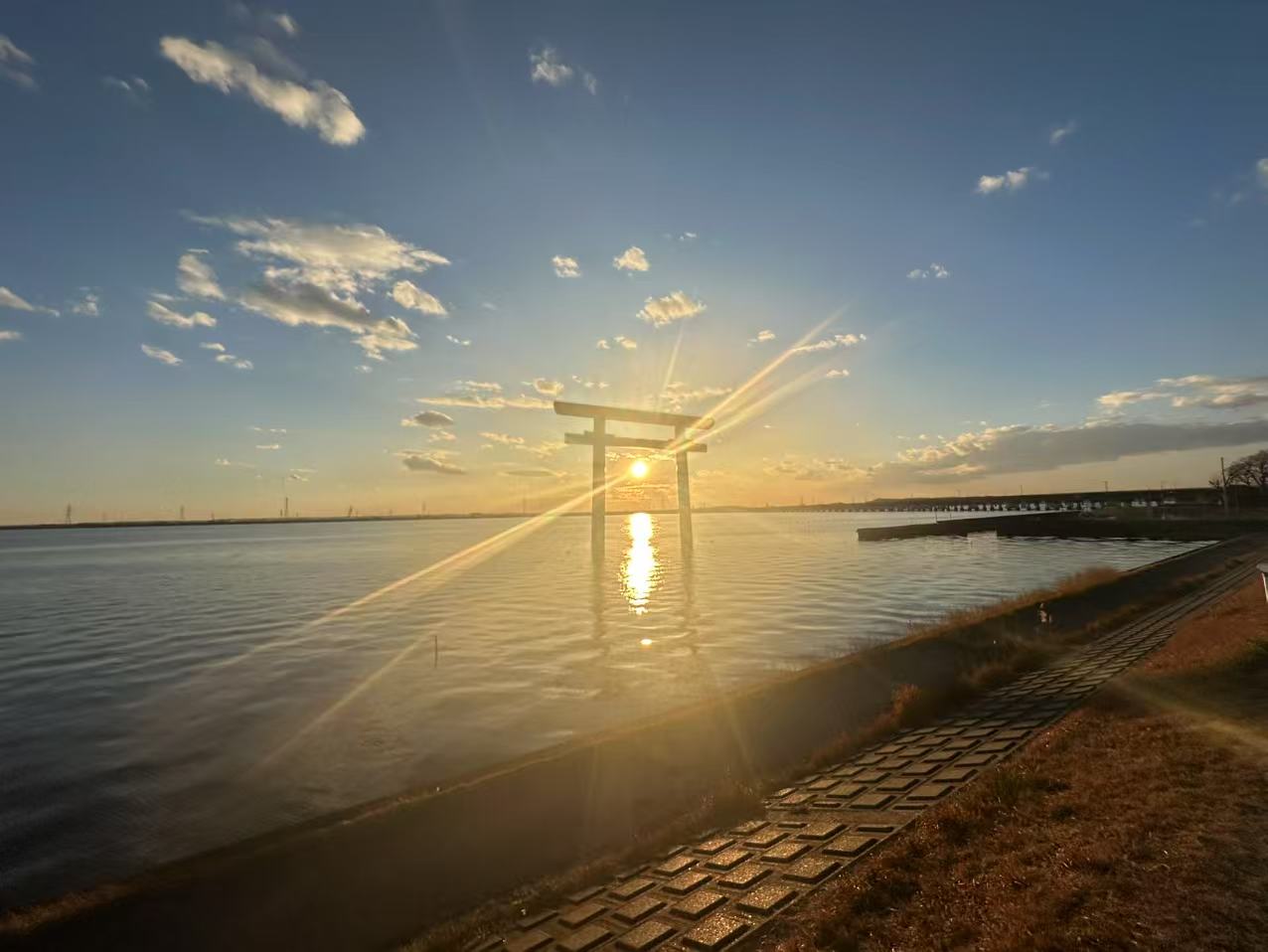
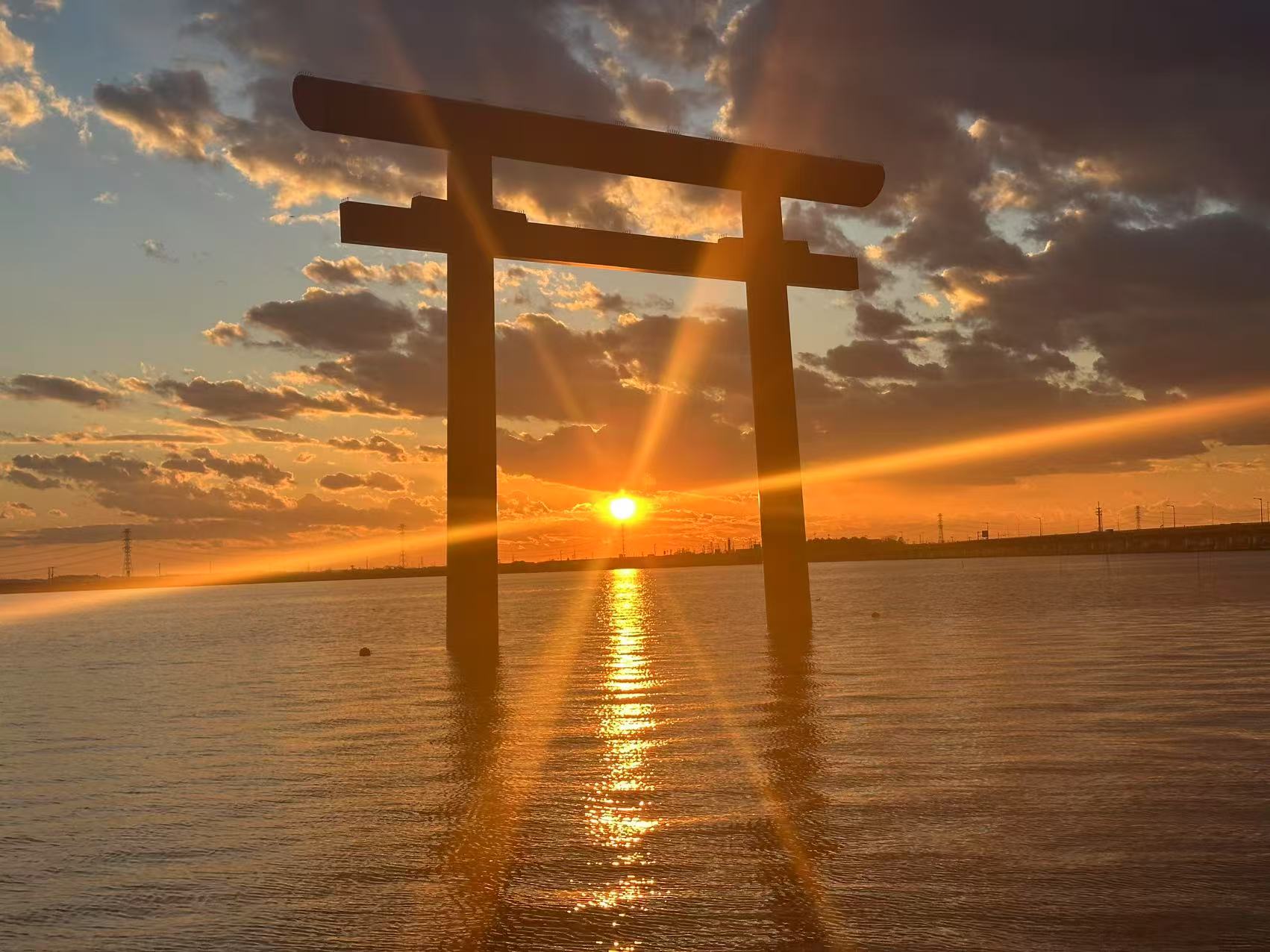
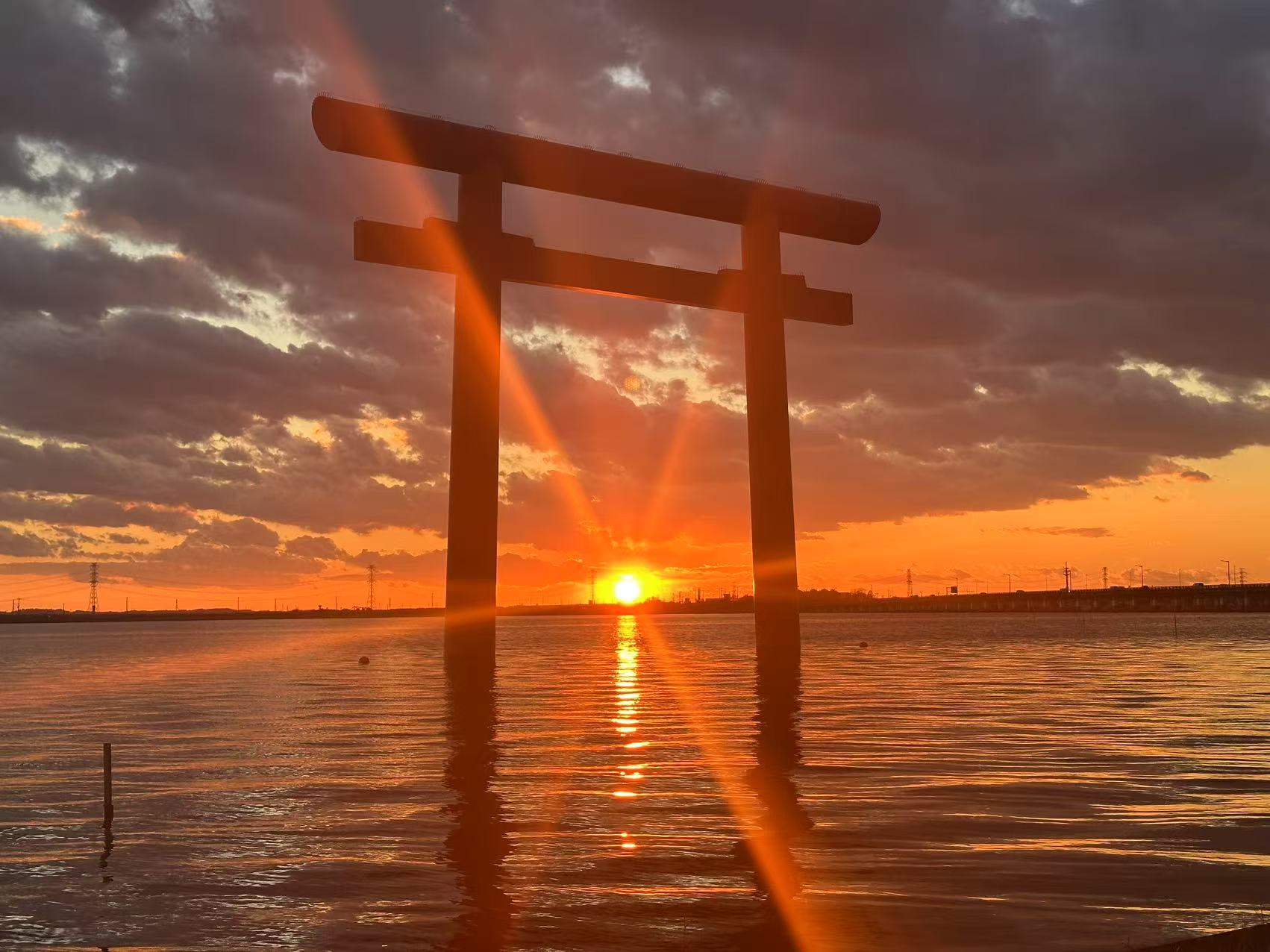
The entire sunset took about 40 mins and as the engulfing horizon took away final bit of warmth, I was suddenly reminded that it was the middle of winter; as the occasion was over and all tourists begin to depart, I was comtemplating the end of My 2024 Japan travel: the 1 hour walk ahead back to the Kashima Station, the train back to Tokyo which I had to catch and all the packaging I had to do at hotel. But it’s like the world we live in, once the fun was over, we return to our somewhat tedious duties, with no chance for such fun again in any near future, at least not before I graduate my PhD. Though unlikely, It is for this reason I felt compelled to blog down the best part of the travel so that it’s not lost in memory.
Conclusion
After I finished this blog, which initially felt a bit messy due to the inclusion of three seemingly unrelated pieces. In some weird way they are all tied to each other thematically, which I guess was something I hoped to convey in the beginning. And as you can see by the length of a mere one-day travel, I couldn’t hope to replicate my efforts for other parts of the travel, though admitted not everyday was as eventful. Once again I am grateful to my travel companions for providing this experience and I am hoping that at some point after I survived the information theory we will meet at some places again.
Enjoy Reading This Article?
Here are some more articles you might like to read next: